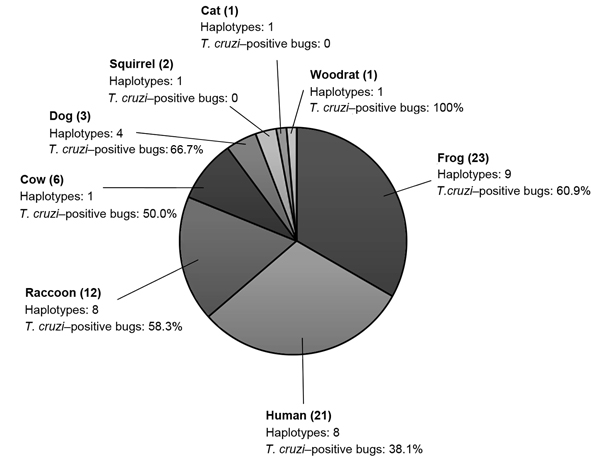Volume 20, Number 12—December 2014
Dispatch
Triatoma sanguisuga Blood Meals and Potential for Chagas Disease, Louisiana, USA
Figure

Figure. Vertebrate blood meal sources of Triatoma sanguisuga kissing bugs detected by 12S rDNA assay (10). The numbers of triatomines containing each vertebrate blood source are indicated in parenthesis. The numbers of haplotypes of each vertebrate source and the Trypanosoma cruzi infection prevalence in the triatomines containing this vertebrate blood source are indicated.
References
- Bern C, Kjos S, Yabsley MJ, Montgomery SP. Trypanosoma cruzi and Chagas’ disease in the United States. Clin Microbiol Rev. 2011;24:655–81. DOIPubMedGoogle Scholar
- Cantey PT, Stramer SL, Townsend RL, Kamel H, Ofafa K, Todd CW, The United States Trypanosoma cruzi Infection Study: evidence for vector-borne transmission of the parasite that causes Chagas disease among United States blood donors. Transfusion. 2012;52:1922–30. DOIPubMedGoogle Scholar
- Waleckx E, Depickere S, Salas R, Aliaga C, Monje M, Calle H, New discoveries of sylvatic Triatoma infestans (Hemiptera: Reduviidae) throughout the Bolivian Chaco. Am J Trop Med Hyg. 2012;86:455–8. DOIPubMedGoogle Scholar
- Click Lambert R, Kolivras KN, Resler LM, Brewster CC, Paulson SL. The potential for emergence of Chagas disease in the United States. Geospat Health. 2008;2:227–39 .PubMedGoogle Scholar
- Zeledon R, Beard CB, Diaz JCP, Leiby DA, Dorn PL, Coura JR. An appraisal of the status of Chagas disease in the United States. Oxford (UK): Elsevier; 2012.
- Dorn PL, Perniciaro L, Yabsley MJ, Roellig DM, Balsamo G, Diaz J, Autochthonous transmission of Trypanosoma cruzi, Louisiana. Emerg Infect Dis. 2007;13:605–7. DOIPubMedGoogle Scholar
- Lent H, Wygodzinsky P. Revision of the triatominae (Hemiptera, Reduviidae), and their significance as vectors of Chagas' disease. American Museum of Natural History. 1979;163:321–4.
- Cesa K, Caillouet KA, Dorn PL, Wesson DM. High Trypanosoma cruzi (Kinetoplastida: Trypanosomatidae) prevalence in Triatoma sanguisuga (Hemiptera: Redviidae) in southeastern Louisiana. J Med Entomol. 2011;48:1091–4. DOIPubMedGoogle Scholar
- Moser DR, Kirchhoff LV, Donelson JE. Detection of Trypanosoma cruzi by DNA amplification using the polymerase chain reaction. J Clin Microbiol. 1989;27:1477–82 .PubMedGoogle Scholar
- Stevens L, Dorn PL, Hobson J, de la Rua NM, Lucero DE, Klotz JH, Vector blood meals and Chagas disease transmission potential, United States. Emerg Infect Dis. 2012;18:646–9. DOIPubMedGoogle Scholar
- Dundee HA, Rossman DA. The amphibians and reptiles of Louisiana. Baton Rouge (LA): Louisiana State University Press; 1989. p. 91–2.
- Kjos SA, Snowden KF, Craig TM, Lewis B, Ronald N, Olson JK. Distribution and characterization of canine Chagas disease in Texas. Vet Parasitol. 2008;152:249–56. DOIPubMedGoogle Scholar
- Nieto PD, Boughton R, Dorn PL, Steurer F, Raychaudhuri S, Esfandiari J, Comparison of two immunochromatographic assays and the indirect immunofluorescence antibody test for diagnosis of Trypanosoma cruzi infection in dogs in south central Louisiana. Vet Parasitol. 2009;165:241–7. DOIPubMedGoogle Scholar
- Klotz SA, Schmidt JO, Dorn PL, Ivanyi C, Sullivan KR, Stevens L. Free-roaming kissing bugs, vectors of Chagas disease, feed often on humans in the Southwest. Am J Med. 2014;127:421–6. DOIPubMedGoogle Scholar
- Kjos SA, Marcet PL, Yabsley MJ, Kitron U, Snowden KF, Logan KS, Identification of blood meal sources and Trypanosoma cruzi infection in triatomine bugs (Hemiptera: Reduviidae) from residential settings in Texas, the United States. J Med Entomol. 2013;50:1126–39. DOIPubMedGoogle Scholar
1Current affiliation: Universidad Autónoma de Yucatán, Mérida, México
Page created: November 19, 2014
Page updated: November 19, 2014
Page reviewed: November 19, 2014
The conclusions, findings, and opinions expressed by authors contributing to this journal do not necessarily reflect the official position of the U.S. Department of Health and Human Services, the Public Health Service, the Centers for Disease Control and Prevention, or the authors' affiliated institutions. Use of trade names is for identification only and does not imply endorsement by any of the groups named above.